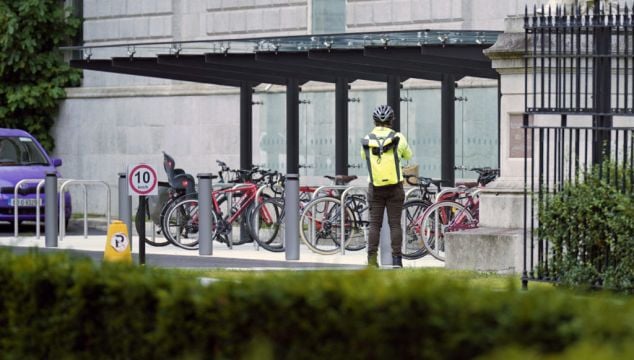The Office of Public Works (OPW) was hoping the €336,000 bicycle shed at Leinster House could become a model design to be adapted and reused at other historic properties.
New documents also detail how the OPW looked at prefabricated shelters for the parliamentary complex but “none were found suitable for [the] location.”
An architectural heritage impact assessment said the project was proving a “challenge” because of its sensitive historic location.
It said the bike shed needed to be “carefully treated and considered,” so as not to ruin vistas of Leinster House, the National Gallery or the Natural History Museum.
The assessment said the Oireachtas had also asked for the shelter to be “visible” to the public to help “demonstrate leadership in this sustainability action.”
However, the project was beset by delays and ended up costing €335,000, expenditure described as “inexplicable and inexcusable” by Taoiseach Simon Harris.
The chairman of the OPW John Conlon told an Oireachtas Committee last week the cost was “extraordinary” and wasteful public expenditure is likely to be a key issue in the general election.
Records released by the Oireachtas under FOI laws describe how several possible sites were looked at for the project including one that was dismissed on security grounds and garda advice.
The architectural assessment said: “The structural element of the shelter is to be as visually light as possible and of good quality material.
“This design could be adapted and used in other heritage properties. The rain screen will be glazed for least visual impact.”
It also said the shed needed to be “reversible” so that the main part of the shelter could be moved to a different location if needed in the future.
“The design should allow for the shelter to be extended without significant alterations to the existing structure,” said the report.
“Shelter should be easy to maintain and repair.”
The assessment said the installation would be for 18 stands, catering for 36 bicycles, and “beneath a bespoke steel-framed, glazed canopy.”
It warned that four parking spaces would be lost, but said the location would cause “the least impact on the setting of Leinster House and its environs.”
The report said that the OPW had been involved in ongoing works including landscaping and fabric repairs as part of the restoration of Leinster House.
It said: “Provision of enhanced cycling facilities will provide a viable alternative to car transport and ultimately help to reduce the requirement for car parking within the complex.
“This is a welcome aspiration to support the appropriate presentation of this important urban complex of buildings.”
The assessment said another advantage of the location was that refurbishment of the nearby National Gallery had only recently been completed making further works there unlikely “for the foreseeable future.”
It added: “[The] bicycle shelter will need to be a bespoke design to respond to the particulars of this site.
“A review of prefabricated shelters currently available was carried out. None were found suitable for this location.”
The bike shed also needed to be “informed by both the historic and modern materials already in evidence” at Leinster House.
This included colour and style coordination with paving, stone seating, railings, cast iron grilles, and rainwater pipes which had a “darker finish.”
It said another design need was that the bicycle shelter be kept to the “fenestration rhythm and string course of the National Gallery elevation.”
It added: “The structure is to be steel, matt factory powder coated to darker grey colour ‘railings’ or similar to reflect the colour palette of the other metal fixtures and fittings within the complex.”







